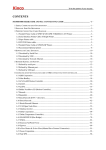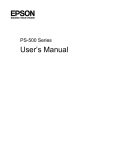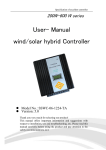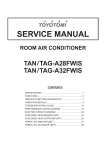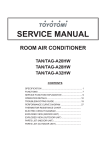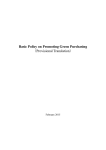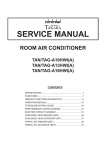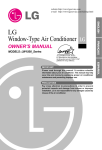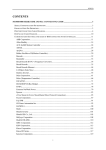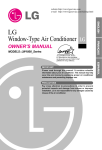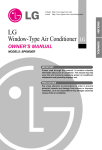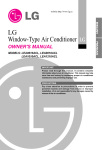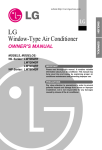Download LG LW8000PR Air Conditioner
Transcript
MODELS: LW7000_Series LW8000_Series FRANÇAIS OWNER'S MANUAL ENGLISH LG Window-Type Air Conditioner LG As an ENERGY STAR® Partner, LG Electronics Inc. has Determined that this product meets the ENERGY STAR® guidelines for energy efficiency. Please read through this manual. It contains valuable information about your air conditioner. This manual may help save time and money by explaining proper air conditioner maintenance and preventing improper use. PRECAUTIONS Pay close attention to precautions in order to prevent potential hazards and damage from misuse or improper installation. LG is not responsible for any damages caused by misuse of the air conditioner. ESPAÑOL IMPORTANT Window-Type Air Conditioner Owner’s Manual TABLE OF CONTENTS F or Your Records Write the model and serial numbers here: Model # Serial # 1. Safety Precautions You can find them on a label on the side of each unit. 2. Operating Instructions Dealer's Name 3. Care and Maintenance Date Purchased 4. Hardware Installation R ead This Manual 5. Common Issues Inside you will find many helpful hints on how to use and maintain your air conditioner properly. Just a little preventive care on your part can save you a great deal of time and money over the life of your air conditioner. You'll find many answers to common problems in the chart of troubleshooting tips. If you review our chart of Troubleshooting Tips first, you may not need to call for service at all. CAUTION • Contact the authorized service technician for repair or maintenance of this unit. • Contact the installer for installation of this unit. • The air conditioner is not intended for use by young children or invalids without supervision. • Young children should be supervised to ensure that they do not play with the air conditioner. 2 Safety Precautions Precautions WARNING This symbol shows the possibility of death or serious injury. CAUTION This symbol indicates the possibility of injury or damage to property. Never Do This Always Do This ■ The following items are classified by these symbols. WARNING WARNING Plug in the power plug properly. • Otherwise, it will cause electric shock or fire due to heat generation or electric shock. Do not modify power cord length or share the outlet with other appliances. • It will cause electric shock or fire due to heat generation. Always plug into a grounded outlet. Do not operate or stop the unit by inserting or pulling out the power plug. • It will cause electric shock or fire due to heat generation. Do not operate with wet hands or in damp environment. • It will cause electric shock. Do not allow water to run into electric parts. • No grounding may cause electric shock (See Installation Manual). Unplug the unit if strange sounds, odors, or smoke comes from it. • It may cause fire and electric shock accident. Keep firearms away. • It will cause failure of machine or electric shock. Do not use the socket if it is loose or damaged. • It may cause fire. • It may cause fire and electric shock. • It may cause fire and electric shock. Do not use the power cord close to the heating tools. 3 Do not damage or use an unspecified power cord. • It will cause electric shock or fire. • If the supply cord is damaged, it must be replaced by the manufacturer or its service agent or a similarly qualified person in order to avoid a hazard. (Y attachment) Do not direct airflow at room occupants only. • This could damage your health. Always install air leakage breaker and a dedicated switching board. • No installation may cause fire and electric shock accident. Do not open the entrance during operation. • It may cause electric shock. Do not use the power cord near flammable gas or combustibles such as gasoline, benzene, thinner, etc. • It may cause an explosion or fire. ENGLISH To prevent injury and property damage, follow these instructions. Incorrect operation due to ignoring instructions will cause harm or damage, the seriousness of which is indicated by the following symbols. WARNING WARNING Ventilate before operating air conditioner when gas goes out. Do not disassemble or modify products randomly. • It may cause explosion, fire, and burn. • It may cause failure and electric shock. CAUTION CAUTION Never touch the metal parts of the unit when removing the filter. • They are sharp and may cause injury. When cleaning the unit, first make sure the power and breaker are turned off. • Since the fan rotates at high speed during operation, it may cause injury. Stop operation in storm or hurricanes. • Operation with windows opened may cause wetting of indoor and soaking of household furniture. Do not place obstacles around the absorption inlet or output. • It may cause failure of appliance or accident. Do not use strong detergent such as wax or thinner but use a soft cloth. • Appearance may be deteriorated due to change of product color or scratching of its surface. Do not clean the air conditioner with water. • Water may enter the unit and degrade the insulation. It may cause an electric shock. Do not put a pet or house plant where it will be exposed to direct air flow. • This could injure the pet or plant. Hold the plug by the head when taking it out. • It may cause electric shock and damage. Ensure that an installation console of the outdoor appliance is not damaged due to the use for a long time. • If leaving appliance damaged, there is concern of damage due to the falling of product. Do not place heavy object on the power cord and take care so that the cord should not be pressed. • There is danger of fire or electric shock. If water enters the product, turn off the the power switch of the main body of appliance. Contact service center after taking the power-plug out from the socket. 4 Ventilate well when used together with a stove, etc. • An oxygen shortage may occur. Do not use appliance for special purpose such as animals or vegetables, precision machine, or conservation of art articles. • It may cause damage of animals or vegetables or loss of property. Turn off the main power switch when not using it for a long time. • It may cause failure of product or fire. Always insert the filters securely. Clean it every two weeks. • Operation without filters will cause failure. Do not drink water drained from air conditioner. • It contains containments and will make you sick. Safety Precautions Prior to Operation ENGLISH Preparing for operation 1 Contact an installation specialist for installation. 2 Plug in the power plug properly. 3 Do not share the same outlet with other appliances 4 Do not use an extension cord. 5 Do not start/stop operation by plugging/unplugging the power cord. 6 If cord/plug is damaged, replace only with an authorized part. Usage 1 Being exposed to direct airflow for an extended period of time could be hazardous to your health. Do not expose occupants, pets, or plants to direct airflow for extended periods of time. 2 Due to the possibility of oxygen deficiency, ventilate the room when used together with stoves or other heating devices. 3 Do not use this air conditioner for non-specified special purposes (e.g. preserving precision devices, food, pets, plants, and art objects). Usage in such a manner could harm such property. Cleaning and maintenance 1 Do not touch the metal parts of the unit when removing the filter. Injuries can occur when handling sharp metal edges. 2 Do not use water to clean inside the air conditioner. Exposure to water can destroy the insulation, leading to possible electric shock. 3 When cleaning the unit, first make sure that the power and breaker are turned off. The fan rotates at a very high speed during operation. There is a possibility of injury if the unit’s power is accidentally triggered on while cleaning inner parts of the unit. Service For repair and maintenance, contact your authorized service dealer. 5 Operating Instructions Remote Control Operations The remote control and control panel will look like one of the following pictures. 6 COOL FAN DRY AIR PURIFIER FAN INDOOR ENERGY SAVER DESIRED 7 AIR PURIFIER CLEAN FILTER Air Purifier Power 1 Temp 2 Fan Speed FAN AIR TIMER SPEED MODE PURIFIER TEMP 4 POWER Sleep Mode Timer Auto Swing 3 8 5 4 3 7 Cool 2 1 Power ˚F F1 LOW F2 MED F3 HIGH Energy Saver 5 1 6 Temp Fan Dry Timer 2 2 TEMP Fan Speed 4 Timer 5 3 5 4 1 6 Mode 3 7 AIR PURIFIER 1 POWER Operation starts when this button is pressed and stops when you press the button again. • Press the Air Purifier button. Operation will start when the button is pressed and stop when the button is pressed again. 2 TEMPERATURE CONTROL The thermostat monitors room temperature to maintain the desired temperature. The thermostat can be set between 60°F~86°F (16°C~30°C). The unit takes an average of 30 minutes to adjust the room temperature by 1°F. • Set the fan speed again with the remote control. You can select the fan speed in three steps-high, low or medium. Each time the button is pressed, the fan speed mode is shifted. • If you press the only Air Purifier button, only air purifying operates without cooling. Then, fan speed is low. You can select the fan speed in three steps; high, low, or medium. Each time the fan speed button is pressed, the fan speed mode is shifted. 3 OPERATION MODE SELECTOR Select cooling mode to cool the room. Select energy saver mode for energy saving operation. Select fan mode for basic ventilating fan operation. Select dry mode for dry operation. 4 FAN SPEED SELECTOR 8 SLEEP MODE For increased power while cooling, select a higher fan speed. 3 steps: High ➔ Low ➔ Med • Press the sleep mode button to set the time you want the unit to turn off automatically. • Every time you push this button, the remaining time will be set as follows. (1Hour → 2Hours → 3Hours → 4Hours → 5Hours → 6Hours → 7Hours → 0Hours → 1Hour → 2Hours → ...) 5 ON/OFF TIMER The timer can be set to start and stop the unit in hourly increments (up to 12 hours). 6 REMOTE CONTROL SENSOR NOTE : CLEAN FILTER You can see "CLEAN FILTER" display after 1000 hours that it is the time of cleaning filter when operating in Air purifier. AUTO RESTART In failure of electric power, the unit runs as previous setting operation. Inserting the Remote Control Batteries 1 Push out the cover on the back of the remote control with your thumb 2 Pay attention to polarity and insert two new AAA 1.5V batteries. 3 Reattach the cover. NOTE: Do not use rechargeable batteries. Make sure that both batteries are new. • In order to prevent discharge, remove the batteries from the remote control if the air conditioner is not going to be used for an extended period of time Keep the remote control away from extremely hot or humid places. To maintain optimal operation of the remote control, the remote sensor should not be exposed to direct sunlight. • The remote control can be mounted on a wall using the mountable holder. 7 ENGLISH Remote Control Operations Operating Instructions Adjusting the Air Flow Direction Vent Control For maximum cooling efficiency, CLOSE the vent. This will allow internal air circulation. OPEN the vent to discharge stale air. CLOSE VENT Part A OPEN NOTE : Before using the ventilation feature, position the vent lever by pulling Part A out straight and snapping it into place. Adjusting the Air Flow Direction Airflow can be adjusted by changing the direction of the air conditioner's louvers. This can also increase the cooling efficiency of the air conditioner. • Adjusting Horizontal Air Flow Direction Adjusting the vertical louvers left and right will change horizontal airflow. • Adjusting Vertical Air Flow Direction Adjusting the horizontal vane up and down will change vertical airflow. The vane can be adjusted by nudging the back or up and down of the vane. Adjusting horizontal air flow Adjusting vertical air flow • Recommended orientation of louvers Adjust louvers to face upwards when cooling to maximize cooling efficiency. 8 Care and Maintenance Care and Maintenance Air Filter The air filter behind the inlet grille should be checked and cleaned at least once every 2 weeks (or as necessary) to maintain optimal performance of the air conditioner. How to remove the air filter 1 The grille may be opened from the top for easy maintenance after installation. 2 Open the inlet grille by pulling off the exposed door on the top of the unit (based on installation). 3 Pull the tab slightly to release the filter. Pull the filter in the same direction as the opening. 4 Clean the filter with warm, soapy water. The water should be below 40°C (104°F). 5 Rinse off and gently shake off excess water from the filter. Let it dry before replaceing it. Drainage The base pan may overflow due to high humidity. To drain the excess water, remove the drain cap from the back of the unit and secure the drainpipe. When pressing the drainpipe into place, apply force in the direction away from the fins to avoid injuring yourself. Drain pipe Drain cap 9 ENGLISH Turn the power off and unplug the power plug before cleaning the air conditioner. Remote Control Operations Air Purifying Filter (Optional) The Air Purifying filter behind the air filter should be checked and cleaned once every 3 months or more often if necessary. 1 After removing the Air Purifying Filter, pull slightly forward to remove the Air Purifying filter. 2 Soak the Air Purifying Filter in water mixed with a mild detergent for 20~30 minutes. 3 Dry the Air Purifying Filter in the shade for a day.(The moisture must be removed completely on this part.) 4 Note the cuts of electric discharge lines. 5 Re-install the Air Purifying Filter to the original position. Don't touch this Air Purifying Filter within 10 seconds after opening the inlet grille; it may cause an electric shock. 10 Hardware Installation Hardware Installation ENGLISH Product Features CAUTION This appliance should be installed in accordance with national wiring regulations. This guide acts as a guide to help to explain product features. 13 6 7 17 9 5 8 1 11 14 12 2 4 3 15 1. CABINET 2. FRONT GRILLE 3. AIR FILTER 4. AIR INTAKE (INLET GRILLE) 5. AIR DISCHARGE 6. VERTICAL AIR DEFLECTOR (HORIZONTAL LOUVER) 7. EVAPORATOR 8. HORIZONTAL AIR DEFLECTOR (VERTICAL LOUVER) 10 16 9. CONTROL PANEL 10. POWER CORD 11. COMPRESSOR 12. BASE PAN 13. BRACE 14. CONDENSER 15. REMOTE CONTROLLER 16. AIR PURIFYING FILTER (Optional) 17. CASE, FILTER (Optional) Installing the Power cord You can choose between two methods below according to your window stool shape and preference. Using slit "A" Using slit "B" • Fasten the stopper using 2 screw holes, and lead out the power cord through slit "A". • Fasten the stopper using left screw hole, and rotate properly to lead the power cord out through slit "B". A B Power cord Power cord 11 How to Install the Unit 1 To prevent vibration and noise, make sure the unit Fence is installed securely and firmly Awning 2 Install the unit where the sunlight does not shine directly on the unit. Cooled air Heat radiation at least 12" and there should be no obstacles, such as a fence or wall, within 20" from the back of the cabinet because it will prevent heat radiation of the condenser. Restriction of outside air will greatly reduce the cooling efficiency of the air conditioner. 30"~60" 3 The outside of the cabinet must extend outward for About 1/2" Over 20" CAUTION: All side louvers of the cabinet must remain exposed to the outside of the structure. 4 Install the unit a little slanted so the back is slightly lower than the front (about 1/2"). This will force condensed water to flow to the outside. 5 Install the unit with the bottom about 30"~60" above the floor level. Window Requirements NOTE: All supporting parts should be secured to firm wood, masonry, or metal. • This unit is designed for installation in standard double hung windows with actual opening widths from 25" to 36". • The top and bottom window sash must open sufficiently to allow a clear vertical opening of 15" from the bottom of the upper sash to the window stool. 25" to 36" 15" min (With frame curtain) Stool Offset 1 /2" to 11/4" Sill Interior wall 20 1/12" min. (Without frame curtain) 12 Exterior 2 1 5 6 3 4 7 8 NO. 1 2 3 4 5 6 7 8 9 10 11 12 13 13 10 12 9 11 NAME OF PARTS FRAME CURTAIN SILL SUPPORT BOLT NUT SCREW (TYPE A) SCREW (TYPE B) SCREW (TYPE C) FOAM-STRIP UPPER GUIDE FOAM-PE FRAME GUIDE WINDOW LOCKING BRACKET FOAM-PE Q'TY 2 2 2 2 16 3 5 1 1 1 2 1 1 Suggested Tool Requirements SCREWDRIVER(+, -), RULER, KNIFE, HAMMER, PENCIL, LEVEL PREPARATION OF CHASSIS Shipping Screws 1 Remove the screws which fasten the cabinet at both sides and at the back. 2 Slide the unit from the cabinet by gripping the base pan handle and pulling forward while bracing the cabinet. 3 Cut the window sash seal to the proper length. Peel off the backing and attach the Foam-PE underside of the window sash. to the 4 Remove the backing from the top upper guide Foam-PE and attach it to the bottom of the Upper Guide . 5 Attach the upper guide onto the top of the cabinet with 3 Type A screws . 6 Insert the Frame Guides into the bottom of the 9 cabinet. 13 7 Insert the Frame Curtain Frame Guides into the Upper Guide 10 and (Type A) . 9 5 8 Fasten the curtains to the unit with 4 Type A screws . 11 5 11 5 13 (Type A) ENGLISH Installation Kits Contents Cabinet Installation 1 Open the window. Mark a line on center of the window stool. Carefully place the cabinet on the window stool and align the center mark on the bottom front with the center line marked in the window stool. Upper Guide Window stool Front Angle Fig. 1 2 Pull the bottom window sash down behind the Upper Guide Window Sash Upper guide 9 until it meets. Foam-pe 13 NOTE: Do not pull the window sash down tightly that the movement of Frame Curtain is restricted. Cabinet Frame Curtain 1 Foam-pe 10 Fig. 2 3 Loosely assemble the Sill Support using the parts INDOOR OUTDOOR in Fig. 3. Sill Support Bolt 3 Nut 2 4 Fig. 3 Screw(Type A) 5 Frame Guide 11 4 Select the position that will place the Sill Support About 1/2" near the outer most point on sill (See Fig. 4) NOTE: Be careful when you install the cabinet (Frame are broken easily). Guides Cabinet 5 Attach the Sill Support to the cabinet track hole in relation to the selected position using 2 Type A screws in each support (See Fig. 4). 14 INDOOR OUTDOOR Fig. 4 Screw(Type B) 6 About 1/2" (about 1/2") downward toward the outside (See Fig. 5). Adjust the bolt and the nut of Sill Support balancing the cabinet. for Sill Support 2 7 Attach the cabinet to the window stool by driving (Type B: Length 16mm (5/8 inch) the screws and below.) through the front angle into window stool. Sash track 8 Pull each Frame Curtain fully to each window sash track, and repeat step 2. Front Angle Screw(Type B) Sill Support 6 2 Fig. 5 9 Attach each Frame Curtain screws the window sash using (Type C). (See Fig. 6) Type C CAUTION: Do not drill a hole in the bottom pan. The unit is designed to operate with approximately 1/2" of water in bottom pan. There is no need to add water if the pan is dry. 7 Fig. 6 10 Slide the unit into the cabinet. (See Fig. 7) CAUTION: For security purpose, reinstall screws (Type A) at cabinet's sides. Screw(Type A) Power cord Screw (Type A) Fig. 7 11 Cut the Foam-Strip to the proper length and insert between the upper window sash and the lower window sash. (See Fig. 8) Foam-Strip 8 Fig. 8 15 ENGLISH 6 The cabinet should be installed with a very slight tilt 12 Attach the Window Locking Bracket C screw with a Type Window locking bracket 12 . (See Fig. 9) Fig. 9 13 Attach the front grille to the cabinet by inserting the tabs on the grille into the tabs on the front of the cabinet. Push the grille in until it snaps into place. (See Fig. 10) Fig. 10 14 Pull down the inlet grille and secure it with a Type A screw through the front grille. (See Fig. 11) 15 Window installation of room air conditioner is now completed. See ELECTRICAL DATA for attaching power cord to electrical outlet. Fig. 11 Electrical Data Line Cord Plug Use Wall Receptacle Do not under any circumstances cut or remove the grounding prong from the plug. Power supply cord with 3-prong grounding plug Power Supply Use 15 AMP, time delay fuse or circuit breaker. Standard 125V, 3-wire grounding receptacle rated 15A, 125V AC Use of extension cords • Because of potential safety hazards, we strongly discourage the use of an extension cord. However, if you wish to use an extension cord, use a CSA certified/UL-listed 3-wire (grounding) extension cord, rated at 15A, 125V. 16 IMPORTANT (PLEASE READ CAREFULLY) FOR THE USER'S PERSONAL SAFETY, THIS APPLIANCE MUST BE PROPERLY GROUNDED The power cord of this appliance is equipped with a three-prong (grounding) plug. Use this with a standard three-slot (grounding) wall power outlet (Fig. 12) to minimize the hazard of electric shock. The customer should have the wall receptacle and circuit checked by a qualified electrician to make sure the receptacle is properly grounded. PREFERRED METHOD Because of potential safety hazards, we strongly discourage the use of an adapter plug. However, if you wish to use an adapter, a TEMPORARY CONNECTION may be made. Use UL-listed adapter, available from most local hardware stores (Fig. 13). The large slot in the adapter must be aligned with the large slot in the receptacle to assure a proper polarity connection. CAUTION: Attaching the adapter ground terminal to the wall receptacle cover screw does not ground the appliance unless the cover screw is metal, and not insulated, and the wall receptacle is grounded through the house wiring. The customer should have the circuit checked by a qualified electrician to make sure the receptacle is properly grounded. Disconnect the power cord from the adapter, using one hand on each. Otherwise, the adapter ground terminal might break. DO NOT USE the appliance with a broken adapter plug. Ensure proper ground exists before use Fig. 12 DO NOT CUT OR REMOVE THE THIRD (GROUND) PRONG FROM THE POWER PLUG. B. SITUATIONS WHEN THE APPLIANCE WILL BE DISCONNECTED OFTEN. Do not use an adapter plug in these situations. Unplugging the power cord frequently can lead to an eventual breakage of the ground terminal. The wall power outlet should be replaced by a three-slot (grounding) outlet instead. A. SITUATIONS WHEN THE APPLIANCE WILL BE DISCONNECTED OCCASIONALLY: TEMPORARY METHOD USE OF EXTENSION CORDS Adapter plug Metal screw Because of potential safety hazards, we strongly discourage the use of an extension cord. However, if you wish to use an extension cord, use a CSA certified/UL-listed 3-wire (grounding) extension cord, rated at 15A, 125V. Receptacle cover Fig. 13 17 ENGLISH Electrical Safety Common Issues Common Problems and Solutions Before calling for service, please review the following list of common problems and solutions. The air conditioner is operating normally when: • You hear a pinging noise. This is caused by water being picked up by the condenser on rainy days or in highly humid conditions. This feature is designed to help remove moisture in the air and improve cooling efficiency. • You hear the thermostat click. This is caused by the compressor cycle starting and stopping. • You see water dripping from the rear of the unit. Water may be collected in the base pan in highly humid conditions or on rainy days. This water overflows and drips from the rear of the unit. • You hear the fan running while the compressor is silent. This is a normal operational feature. The air conditioner may be operating abnormally when: Problem Possible Causes What To Do ■ The air conditioner is unplugged or • Make sure the plug is completely plugged into the outlet not plugged in completely The air conditioner does not operate at all Air conditioner does not cool ■ The fuse is blown/circuit breaker is • Check the fuse/circuit breaker box and replace the fuse or reset the breaker triggered ■ Power failure. • In the event of a power failure, set the power control to OFF. When the power is restored, wait 3 minutes to restart the air conditioner to prevent the compressor from overloading ■ Air flow is restricted • Make sure there are no curtains, blinds, furniture or other obstacles in front of the air conditioner ■ The THERMOSTAT may not be set cool enough • Turn the knob to a higher setting. The highest setting provides maximum cooling ■ The air filter is dirty. • Clean the filter at least every 2 weeks. Refer to the “Care and Maintenance” section (p.9) of the manual. ■ The air conditioner was just turned on. • After the air conditioner is turned on, you need to give the air conditioner some time to cool the room. ■ Cold air is escaping. • Check for open furnace floor resisters and cold air returns. • CLOSE the air conditioner vent ■ Cooling coils are iced up • See Ice appears on the air conditioner below ■ The cooling coils are iced over. • Ice may block the air flow and obstruct the air conditioner from properly cooling the room. Set the fan at MED or HIGH while setting the thermostat at 1 or 2 until the ice melts. Ice appears on the air conditioner. ❈ You can refer to the Energy Star program in detail at "www.energystar.gov". 18


















